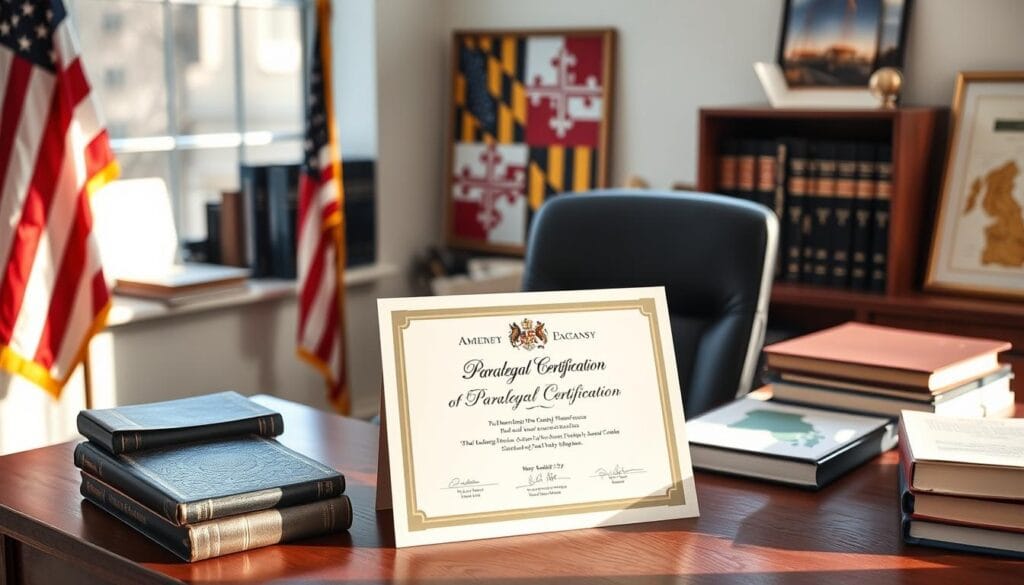Let’s talk about how to becoming a paralegal in Maryland. It’s a career that’s been on my radar for years—first as a curious student flipping through college catalogs, then as someone who’s worked alongside paralegals and seen the real grind. Maryland’s legal scene is buzzing, with law firms, government offices, and corporations all hungry for skilled support staff. If you’re thinking about jumping in, whether you’re fresh out of high school or switching gears mid-career, this guide’s for you. I’ve dug through the details—schools, jobs, salaries, the works—so you don’t have to. Here’s what it takes to make it happen in 2025.
Table of Contents
The Lay of the Land: What’s a Paralegal, Anyway?
Before we get into the how-to, let’s clear up what you’re signing up for. Paralegals are the unsung heroes of the legal world. They dig into case law, draft documents, organize evidence, and keep attorneys on track. But here’s the catch: you can’t give legal advice or argue in court—that’s attorney territory. Still, you’re in the thick of it, making sense of chaos and keeping cases moving. It’s detail-oriented work, and it demands focus, but it’s also rewarding if you like puzzles and helping people.
Maryland doesn’t set strict rules for paralegals—no state license, no mandatory degree. That’s the good news. The tricky part? Employers have their own standards, and they’re not messing around. They want training, skills, and sometimes experience before you even get a foot in the door. So, while the state gives you room to maneuver, the job market’s the real gatekeeper.
How to become a paralegal in Maryland?

Step 1: Get the Education You’ll Actually Need
First things first—education. Maryland doesn’t legally require a degree to call yourself a paralegal, but let’s be real: you’re not landing a decent gig with just a high school diploma anymore. I’ve talked to hiring managers at firms in Baltimore and Bethesda, and they all say the same thing—show me some college, or I’m moving on to the next resume.
You’ve got options, depending on how much time and money you’re willing to put in:
- Certificate Programs: These are quick—6 months to a year—and perfect if you’ve already got a bachelor’s in something else. Think $1,500 or so in tuition. Places like Frederick Community College or Georgetown (just over the line in D.C.) offer these, focusing on practical stuff like legal research and writing.
- Associate’s Degree: Two years, usually $10,000-$30,000 total at a community college. Anne Arundel Community College and Montgomery College have solid programs, and they’re approved by the American Bar Association (ABA). That ABA stamp? It’s not required, but it tells employers you’re serious.
- Bachelor’s Degree: Four years, around $39,000 if you stay in-state. Towson University and Stevenson University offer paralegal studies degrees that dig deeper into law and critical thinking. It’s overkill for some jobs, but it sets you up for bigger roles—or even law school—down the road.
Here’s a tip from someone who’s been there: if you can, pick an ABA-approved program. I’ve seen resumes with “ABA” on them jump to the top of the pile. Schools like Harford Community College and the Community College of Baltimore County (CCBC) fit the bill, blending classroom learning with hands-on projects. Online options? University of Maryland Global Campus (UMGC) has you covered—great if you’re juggling work or family.
One thing to watch: costs and timelines vary. A certificate might get you in the door fast, but an associate’s or bachelor’s gives you more staying power. Check program websites for the latest tuition and course details—things shift year to year.
Step 2: Get Your Hands Dirty with Experience
Education’s just the start. You need experience—real, messy, in-the-trenches work. I remember my first internship at a small firm in Towson. I was terrified, fumbling through case files, but by the end, I could spot a missing affidavit from a mile away. That’s the kind of edge employers want.
Most paralegal programs—like CCBC’s or Prince George’s Community College—bake internships into the deal. You might shadow a paralegal at a legal aid office or help prep for a trial. If your program doesn’t offer that, hunt for entry-level gigs yourself. Legal secretary, case assistant, even document clerk—titles don’t matter as much as the exposure. The Maryland Legal Aid Bureau’s a good spot to start; they often take newbies willing to learn.
Why does this matter? Because in 2025, with tech eating up rote tasks like document sorting, firms want paralegals who’ve seen action—someone who’s handled a frantic deadline or wrestled with a tricky statute. Start small if you have to. Every hour counts.
Step 3: Certification—Worth It or Not?

Now, certification. Maryland doesn’t make you get it, but I’ve seen it tip the scales. The National Federation of Paralegal Associations (NFPA) offers two big ones:
- Core Registered Paralegal (CRP): For new grads. You take the Paralegal Core Competency Exam (PCCE) at a Prometric Test Center—think Baltimore or Bethesda—and prove you’ve got the basics down. It’s a confidence booster and a resume flex.
- Registered Paralegal (RP): For the seasoned. You need an associate’s plus six years of work, a bachelor’s plus three, or a master’s plus two, then pass the Paralegal Advanced Competency Exam (PACE). It’s tougher, but it screams expertise.
The Maryland Association of Paralegals (MAP) pushes these hard, and for good reason. I’ve met paralegals who landed jobs at firms like Shulman Rogers in Potomac because that “CRP” or “RP” caught someone’s eye. The National Association of Legal Assistants (NALA) has its own Certified Paralegal (CP) credential too—another solid choice. Costs? A few hundred bucks for the exam, plus study time. You’ll need continuing education (CLE) every two years to keep it, but it’s a small price for the edge it gives.
My take: if you’re fresh out of school, grab the CRP. If you’ve got years under your belt, go for RP or CP. It’s not mandatory, but in a crowded field, it’s like a neon sign saying, “I’m worth hiring.”
Step 4: Find the Job—Where and How
You’ve got the training, the experience, maybe a certification. Now, the job hunt. Maryland’s got 6,190 paralegals as of 2023, per the Bureau of Labor Statistics (BLS), and the number’s climbing—projections range from 6.9% growth by 2032 (Projections Central) to 14% by 2031 (Document 6). That’s a lot of openings, especially near D.C. and Baltimore.
Where do paralegals work here?
- Law Firms: Big names like Pessin Katz in Towson or Rosenberg & Associates in Bethesda hire for everything from litigation to real estate. Small firms need all-rounders; big ones want specialists.
- Corporations: Think Legg Mason in Baltimore or biotech firms in Rockville. They need paralegals for contracts and compliance.
- Government: The Maryland Office of the Attorney General, the Public Defender’s Office, even federal agencies near D.C. like the Department of Justice. Public service vibes, steady hours.
- Nonprofits: Legal aid groups and advocacy orgs—lower pay, higher purpose.
How do you find these? LinkedIn’s a goldmine—search “paralegal Maryland” and see who’s hiring. Indeed and Glassdoor work too, but don’t skip MAP’s job board. I’ve seen folks snag interviews just by chatting at a MAP networking event. Tailor your resume—highlight Westlaw skills or that internship—and write a cover letter that shows you get the gig. Firms like Cordell & Cordell in Baltimore get swamped with applications; make yours stand out.
Step 5: Skills That Pay the Bills
What do you need to shine? I’ve worked with paralegals who could turn a messy case file into a masterpiece, and it boils down to a few key skills:
- Legal Research: Westlaw and LexisNexis are your bread and butter. Know how to find a statute or a precedent fast.
- Writing: Drafting motions or memos—clear, sharp, no fluff. Attorneys lean on you for this.
- Tech: Microsoft Office is table stakes. Case management software like Clio? That’s the 2025 edge.
- Organization: Deadlines don’t wait. Keep files straight, and you’ll save everyone’s sanity.
Here’s a 2025 twist: AI tools are creeping in—think research bots or e-discovery platforms. Learn them. Firms near the Beltway pay more for tech-savvy paralegals—sometimes $10,000 extra a year.
Step 6: Network and Grow
Don’t go it alone. MAP’s been around since 1974, and it’s your ticket to CLE, job leads, and mentors. I’ve seen paralegals meet their next boss at a MAP mixer. The Maryland State Bar Association and Maryland Volunteer Lawyer Service offer events too—get in the room.
Once you’re working, keep learning. CLE keeps certifications alive, but it also keeps you sharp. Specialize if you can—family law, IP, immigration. It’s how you go from $68,000 a year to $80,000-plus.

The Money and the Market: What to Expect
Let’s talk numbers. BLS says Maryland paralegals averaged $68,070 in 2023. Break it down by area:
- Baltimore-Columbia-Towson: $68,600, 3,850 employed.
- Washington-Arlington-Alexandria: $84,530, 10,820 jobs—top-tier pay near D.C.
- Salisbury: $56,970, smaller scene.
Top 10%? Over $80,000 statewide. That’s 2023—expect a bump by 2025 as demand grows. Jobs are there—149 openings a year back in 2015 (Document 1), likely more now with tech and hybrid work shaking things up.
2025 and Beyond: The Future’s Calling
What’s different in 2025? Tech’s the big one. AI’s handling grunt work, so paralegals who master tools like e-discovery or virtual case management are golden. Hybrid work’s still around—Zoom skills matter. Maryland’s D.C. proximity means higher stakes and pay, especially if you’re near the Beltway. Schools are adding “digital paralegal” courses—jump on that if you’re starting now.
Conclusion
So, how do you become a paralegal in Maryland? Start with education—two years at Montgomery College or four at Towson, your call. Get experience—intern at Legal Aid or slog it out as a secretary. Certify if you want an edge, then hunt for jobs through MAP or LinkedIn. Hone your skills, network hard, and keep learning. The market’s growing, the pay’s solid, and the work matters. It’s not easy, but it’s doable—and if you’re reading this, you’re already on your way.
FAQ
How long does it take to become a paralegal in Maryland?
Depends on your path—6 months for a certificate, 2 years for an associate’s, or 4 years for a bachelor’s. Add a few months for experience.
What is the average salary for paralegals in Maryland?
Around $68,070 statewide in 2023, per BLS. Near D.C., it’s closer to $84,530. Expect more by 2025.
Is certification required to become a paralegal in Maryland?
No, it’s optional—but a CRP or CP can make you stand out to employers.

